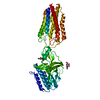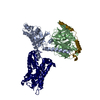+ Open data
Open data
- Basic information
Basic information
| Entry |  | |||||||||
|---|---|---|---|---|---|---|---|---|---|---|
| Title | Cryo-EM structure of the inactive CD97 | |||||||||
 Map data Map data | ||||||||||
 Sample Sample |
| |||||||||
 Keywords Keywords | adhension GPCR /  CD97 / CD97 /  inactive / inactive /  MEMBRANE PROTEIN MEMBRANE PROTEIN | |||||||||
| Function / homology |  Function and homology information Function and homology informationClass B/2 (Secretin family receptors) / secretory granule membrane / G protein-coupled receptor activity / adenylate cyclase-activating G protein-coupled receptor signaling pathway / transmembrane signaling receptor activity / cell-cell signaling /  electron transfer activity / electron transfer activity /  periplasmic space / cell surface receptor signaling pathway / periplasmic space / cell surface receptor signaling pathway /  cell adhesion ...Class B/2 (Secretin family receptors) / secretory granule membrane / G protein-coupled receptor activity / adenylate cyclase-activating G protein-coupled receptor signaling pathway / transmembrane signaling receptor activity / cell-cell signaling / cell adhesion ...Class B/2 (Secretin family receptors) / secretory granule membrane / G protein-coupled receptor activity / adenylate cyclase-activating G protein-coupled receptor signaling pathway / transmembrane signaling receptor activity / cell-cell signaling /  electron transfer activity / electron transfer activity /  periplasmic space / cell surface receptor signaling pathway / periplasmic space / cell surface receptor signaling pathway /  cell adhesion / cell adhesion /  immune response / immune response /  inflammatory response / iron ion binding / G protein-coupled receptor signaling pathway / inflammatory response / iron ion binding / G protein-coupled receptor signaling pathway /  focal adhesion / focal adhesion /  calcium ion binding / calcium ion binding /  heme binding / Neutrophil degranulation / extracellular exosome / heme binding / Neutrophil degranulation / extracellular exosome /  membrane / membrane /  plasma membrane plasma membraneSimilarity search - Function | |||||||||
| Biological species |   Homo sapiens (human) Homo sapiens (human) | |||||||||
| Method |  single particle reconstruction / single particle reconstruction /  cryo EM / Resolution: 3.2 Å cryo EM / Resolution: 3.2 Å | |||||||||
 Authors Authors | Mao C / Zhao R / Dong Y / Gao M / Chen L / Zhang C / Xiao P / Guo J / Qin J / Shen D ...Mao C / Zhao R / Dong Y / Gao M / Chen L / Zhang C / Xiao P / Guo J / Qin J / Shen D / Ji S / Zang S / Zhang H / Wang W / Shen Q / Sun P / Zhang Y | |||||||||
| Funding support |  China, 1 items China, 1 items
| |||||||||
 Citation Citation |  Journal: Mol Cell / Year: 2024 Journal: Mol Cell / Year: 2024Title: Conformational transitions and activation of the adhesion receptor CD97. Authors: Chunyou Mao / Ru-Jia Zhao / Ying-Jun Dong / Mingxin Gao / Li-Nan Chen / Chao Zhang / Peng Xiao / Jia Guo / Jiao Qin / Dan-Dan Shen / Su-Yu Ji / Shao-Kun Zang / Huibing Zhang / Wei-Wei Wang / ...Authors: Chunyou Mao / Ru-Jia Zhao / Ying-Jun Dong / Mingxin Gao / Li-Nan Chen / Chao Zhang / Peng Xiao / Jia Guo / Jiao Qin / Dan-Dan Shen / Su-Yu Ji / Shao-Kun Zang / Huibing Zhang / Wei-Wei Wang / Qingya Shen / Jin-Peng Sun / Yan Zhang /  Abstract: Adhesion G protein-coupled receptors (aGPCRs) are evolutionarily ancient receptors involved in a variety of physiological and pathophysiological processes. Modulators of aGPCR, particularly ...Adhesion G protein-coupled receptors (aGPCRs) are evolutionarily ancient receptors involved in a variety of physiological and pathophysiological processes. Modulators of aGPCR, particularly antagonists, hold therapeutic promise for diseases like cancer and immune and neurological disorders. Hindered by the inactive state structural information, our understanding of antagonist development and aGPCR activation faces challenges. Here, we report the cryo-electron microscopy structures of human CD97, a prototypical aGPCR that plays crucial roles in immune system, in its inactive apo and G13-bound fully active states. Compared with other family GPCRs, CD97 adopts a compact inactive conformation with a constrained ligand pocket. Activation induces significant conformational changes for both extracellular and intracellular sides, creating larger cavities for Stachel sequence binding and G13 engagement. Integrated with functional and metadynamics analyses, our study provides significant mechanistic insights into the activation and signaling of aGPCRs, paving the way for future drug discovery efforts. | |||||||||
| History |
|
- Structure visualization
Structure visualization
| Supplemental images |
|---|
- Downloads & links
Downloads & links
-EMDB archive
| Map data |  emd_35514.map.gz emd_35514.map.gz | 449.1 KB |  EMDB map data format EMDB map data format | |
|---|---|---|---|---|
| Header (meta data) |  emd-35514-v30.xml emd-35514-v30.xml emd-35514.xml emd-35514.xml | 12.2 KB 12.2 KB | Display Display |  EMDB header EMDB header |
| Images |  emd_35514.png emd_35514.png | 41.2 KB | ||
| Filedesc metadata |  emd-35514.cif.gz emd-35514.cif.gz | 5.8 KB | ||
| Archive directory |  http://ftp.pdbj.org/pub/emdb/structures/EMD-35514 http://ftp.pdbj.org/pub/emdb/structures/EMD-35514 ftp://ftp.pdbj.org/pub/emdb/structures/EMD-35514 ftp://ftp.pdbj.org/pub/emdb/structures/EMD-35514 | HTTPS FTP |
-Related structure data
| Related structure data |  8ikjMC  8iklC C: citing same article ( M: atomic model generated by this map |
|---|---|
| Similar structure data | Similarity search - Function & homology  F&H Search F&H Search |
- Links
Links
| EMDB pages |  EMDB (EBI/PDBe) / EMDB (EBI/PDBe) /  EMDataResource EMDataResource |
|---|---|
| Related items in Molecule of the Month |
- Map
Map
| File |  Download / File: emd_35514.map.gz / Format: CCP4 / Size: 64 MB / Type: IMAGE STORED AS FLOATING POINT NUMBER (4 BYTES) Download / File: emd_35514.map.gz / Format: CCP4 / Size: 64 MB / Type: IMAGE STORED AS FLOATING POINT NUMBER (4 BYTES) | ||||||||||||||||||||
|---|---|---|---|---|---|---|---|---|---|---|---|---|---|---|---|---|---|---|---|---|---|
| Voxel size | X=Y=Z: 0.93 Å | ||||||||||||||||||||
| Density |
| ||||||||||||||||||||
| Symmetry | Space group: 1 | ||||||||||||||||||||
| Details | EMDB XML:
|
-Supplemental data
- Sample components
Sample components
-Entire : Adhesion G protein-coupled receptor E5
| Entire | Name: Adhesion G protein-coupled receptor E5 |
|---|---|
| Components |
|
-Supramolecule #1: Adhesion G protein-coupled receptor E5
| Supramolecule | Name: Adhesion G protein-coupled receptor E5 / type: organelle_or_cellular_component / ID: 1 / Parent: 0 / Macromolecule list: #1 |
|---|---|
| Source (natural) | Organism:   Homo sapiens (human) Homo sapiens (human) |
-Macromolecule #1: Adhesion G protein-coupled receptor E5,Soluble cytochrome b562,Ad...
| Macromolecule | Name: Adhesion G protein-coupled receptor E5,Soluble cytochrome b562,Adhesion G protein-coupled receptor E5 subunit beta type: protein_or_peptide / ID: 1 / Number of copies: 1 / Enantiomer: LEVO |
|---|---|
| Source (natural) | Organism:   Homo sapiens (human) Homo sapiens (human) |
| Molecular weight | Theoretical: 72.551656 KDa |
| Recombinant expression | Organism:  Fusarium sinicum (fungus) Fusarium sinicum (fungus) |
| Sequence | String: EDMTFSTWTP PPGVHSQTLS RFFDKVQDLG RDSKTSSAEV TIQNVIKLVD ELMEAPGDVE ALAPPVRHLI ATQLLSNLED IMRILAKSL PKGPFTYISP SNTELTLMIQ ERGDKNVTMG QSSARMKLNW AVAAGAEDPG PAVAGILSIQ NMTTLLANAS L NLHSKKQA ...String: EDMTFSTWTP PPGVHSQTLS RFFDKVQDLG RDSKTSSAEV TIQNVIKLVD ELMEAPGDVE ALAPPVRHLI ATQLLSNLED IMRILAKSL PKGPFTYISP SNTELTLMIQ ERGDKNVTMG QSSARMKLNW AVAAGAEDPG PAVAGILSIQ NMTTLLANAS L NLHSKKQA ELEEIYESSI RGVQLRRLSA VNSIFLSHNN TKELNSPILF AFSHLESSDG EAGRDPPAKD VMPGPRQELL CA FWKSDSD RGGHWATEGC QVLGSKNGST TCQCSSLSSF AILMAHYDVE DWKLTLITRV GLALSLFCLL LCILTFLLVR PIQ GSRTTI HLHLCICLFV GSTIFLAGIE NEGGQVGLRC RLVAGLLHYC FLAAFCWMSL EGLELYFLVV RVFQGQGLST RWLC LIGYG VPLLIVGVSA AIYSKGYGRP RYCWLDFEQG FLWSFLGPVT FIILCNAVIF VTTVWKLTQL AADLEDNWET LNDNL KVIE KADNAAQVKD ALTKMRAAAL DAQKATPPKL EDKSPDSPEM KDFRHGFDIL VGQIDDALKL ANEGKVKEAQ AAAEQL KTT RNAYIQKYLE RARSTLQKAR ALTITAIAQL FLLGCTWVFG LFIFDDRSLV LTYVFTILNC LQGAFLYLLH CLLNKKV RE EYRKWACLVA GGS UniProtKB: Adhesion G protein-coupled receptor E5, Soluble cytochrome b562, Adhesion G protein-coupled receptor E5 |
-Macromolecule #2: 2-acetamido-2-deoxy-beta-D-glucopyranose
| Macromolecule | Name: 2-acetamido-2-deoxy-beta-D-glucopyranose / type: ligand / ID: 2 / Number of copies: 3 / Formula: NAG |
|---|---|
| Molecular weight | Theoretical: 221.208 Da |
| Chemical component information |  ChemComp-NAG: |
-Experimental details
-Structure determination
| Method |  cryo EM cryo EM |
|---|---|
 Processing Processing |  single particle reconstruction single particle reconstruction |
| Aggregation state | particle |
- Sample preparation
Sample preparation
| Buffer | pH: 7.5 |
|---|---|
| Grid | Model: Quantifoil R1.2/1.3 / Material: GOLD / Mesh: 200 |
| Vitrification | Cryogen name: ETHANE |
- Electron microscopy
Electron microscopy
| Microscope | FEI TITAN KRIOS |
|---|---|
| Electron beam | Acceleration voltage: 300 kV / Electron source:  FIELD EMISSION GUN FIELD EMISSION GUN |
| Electron optics | Illumination mode: FLOOD BEAM / Imaging mode: BRIGHT FIELD Bright-field microscopy / Cs: 2.7 mm / Nominal defocus max: 1.5 µm / Nominal defocus min: 0.7000000000000001 µm Bright-field microscopy / Cs: 2.7 mm / Nominal defocus max: 1.5 µm / Nominal defocus min: 0.7000000000000001 µm |
| Sample stage | Specimen holder model: FEI TITAN KRIOS AUTOGRID HOLDER / Cooling holder cryogen: NITROGEN |
| Image recording | Film or detector model: FEI FALCON IV (4k x 4k) / Average electron dose: 52.0 e/Å2 |
| Experimental equipment |  Model: Titan Krios / Image courtesy: FEI Company |
- Image processing
Image processing
| Startup model | Type of model: NONE |
|---|---|
| Initial angle assignment | Type: RANDOM ASSIGNMENT |
| Final angle assignment | Type: MAXIMUM LIKELIHOOD |
| Final reconstruction | Resolution.type: BY AUTHOR / Resolution: 3.2 Å / Resolution method: FSC 0.143 CUT-OFF / Number images used: 540042 |
 Movie
Movie Controller
Controller

















